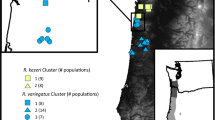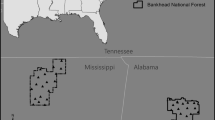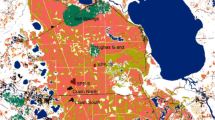Abstract
Context
Conversion of forest ecosystems to human-modified landscapes threatens the persistence of forest-specialist species. However, the local and landscape drivers of population abundance and genetic diversity of these species are largely unknown, especially for elusive and critically endangered species, such as the salamander Pseudoeurycea robertsi—a species microendemic to the Nevado de Toluca volcano, Mexico.
Objectives
We assessed the relative influence of local- and landscape-scale habitat amount and habitat spatial configuration on the number of individuals and genetic diversity of P. robertsi. Given its low vagility, we expected stronger responses to local habitat amount than to landscape variables, with habitat configuration showing the weakest effects on all responses.
Methods
Using multiscale and multimodel inference approaches, we tested the relative effect of local habitat amount (fallen logs volume), landscape habitat amount (forest cover) and landscape configuration (forest edge density and forest fragmentation per se) on the number of salamanders and its genetic diversity.
Results
The number of individuals was more strongly related to local and landscape variables than genetic diversity. As predicted, local habitat amount showed stronger positive effects on number of individuals and number of alleles than forest cover. In addition, all response variables increased in landscapes with lower edge density. Fragmentation per se showed weak influence on all responses.
Conclusions
Fallen logs volume is a major driver of this forest-specialist salamander. Yet, edge density also shapes salamander populations, especially the number of individuals. Retaining fallen logs in forests and increasing forest core areas are critical for salamander conservation.


Similar content being viewed by others
References
Arntzen JW, Smithson A, Oldham RS (1999) Marking and tissue sampling effects on body condition and survival in the newt Triturus cristatus. J Herpetol 33:567–576
Arredondo-León C, Muñoz-Jiménez J, García-Romero A (2008) Recent changes in landscape-dynamics trends in tropical highlands, central Mexico. Interciencia 33:569–577
Arroyo-Rodríguez V, Saldaña-Vázquez RA, Fahrig L, Santos BA (2017) Does forest fragmentation cause an increase in forest temperature? Ecol Res 32:81–88
Bille T (2009) Field observations on the salamanders (Caudata: Ambystomatidae, Plethodontidae) of Nevado de Toluca, Mexico. Salamandra 45:155–164
Broadbent EN, Asner GP, Keller M, Knapp DE, Oliveira PJ, Silva JN (2008) Forest fragmentation and edge effects from deforestation and selective logging in the Brazilian Amazon. Biol Conserv 141:1745–1757
Burnham KP, Anderson DR (2002) Model selection and multimodel inference. A practical information-theoretic approach. Springer, New York
Calcagno V, Mazancourt C (2010) Glmulti: an R package for easy automated model selection with (generalized) linear models. J Stat Softw 34:1–29
Catenazzi A (2015) State of the world’s amphibians. Annu Rev Environ Resour 40:91–119
Chao A, Jost L (2012) Coverage-based rarefaction and extrapolation: standardizing samples by completeness rather than size. Ecology 93:2533–2547
CONABIO, Comisión Nacional para el Conocimiento y Uso de la Biodiversidad (2000) Regionalización. http://www.conabio.gob.mx/conocimiento/regionalizacion/doctos/rtp_109.pdf. Accessed 5 Nov 2018
CONAPO (2010) Delimitación de las zonas metropolitanas de México http://www.conapo.gob.mx/en/CONAPO/Zonas_metropolitanas_2010. Accessed 5 Nov 2018
Coulon A, Cosson JF, Angibault JM, Cargnelutti B, Galan M, Morellet N, Petit E, Aulagnier S, Hewison AJ (2004) Landscape connectivity influences gene flow in a roe deer population inhabiting a fragmented landscape: an individual-based approach. Mol Ecol 13:2841–2850
Crump ML, Scott NJ Jr (1994) Visual encounter Surveys. In: Heyer WR, Donnelly MA, McDiarmid RW, Hayek LC, Foster MC (eds) Measuring and monitoring biological diversity: standard methods for amphibians. Smithsonian Institution Press, Washington, pp 84–92
Cushman SA (2006) Effects of habitat loss and fragmentation on amphibians: a review and prospectus. Biol Conserv 128:231–240
Cushman SA, Shirk A, Landguth EL (2012) Separating the effects of habitat area, fragmentation and matrix resistance on genetic differentiation in complex landscapes. Landscape Ecol 27:369–380
Davic RD, Welsh HH Jr (2004) On the ecological roles of salamanders. Annu Rev Ecol Evol Syst 35:405–434
De la Torre Y (1971) Volcanes de México. 2nd edition - Aguilar, México D.F
deMaynadier PG, Hunter ML (1998) Effects of silvicultural edges on the distribution and abundance of amphibians in Maine. Conserv Biol 12:340–352
DOF, Diario Oficial de la Federación Mexicana (2013): Decreto que reforma, deroga y adiciona diversas disposiciones del diverso publicado el 25 de enero de 1936, por el que se declaró Parque Nacional la montaña denominada “Nevado de Toluca” que fue modificado por el diverso publicado el 19 de febrero de 1937. http://dof.gob.mx/nota_detalle_popup.php?codigo=5315889. Accessed 5 Nov 2018
Eigenbrod F, Hecnar SJ, Fahrig L (2008) The relative effect of road traffic and forest cover on anuran populations. Biol Conserv 141:35–46
Eigenbrod F, Hecnar SJ, Fahrig L (2011) Sub-optimal study design has major impacts on landscape-scale inference. Biol Conserv 144:298–305
Ewers RM, Didham RK (2006) Confounding factors in the detection of species responses to habitat fragmentation. Biol Rev 81:117–142
Fahrig L (2003) Effects of habitat fragmentation on biodiversity. Annu Rev Ecol Evol Syst 34:487–515
Fahrig L (2013) Rethinking patch size and isolation effects: the habitat amount hypothesis. J Biogeogr 40:1649–1663
Fahrig L (2017) Ecological responses to habitat fragmentation per se. Annu Rev Ecol Evol Syst 48:1–23
Fahrig L, Baudry J, Brotons L, Burel FG, Crist TO, Fuller RJ, Sirami C, Siriwardena GM, Martin JL (2011) Functional landscape heterogeneity and animal biodiversity in agricultural landscapes. Ecol Lett 14:101–112
Fahrig L, Arroyo-Rodríguez V, Bennett J, Boucher-Lalonde V, Cazeta E, Currie D, Eigenbrod F, Ford A, Jaeger J, Koper N, Martin A, Metzger JP, Morrison P, Rhodes J, Saunders D, Simberloff D, Smith A, Tischendorf L, Vellend M, Watling J (2019) Is habitat fragmentation bad for biodiversity? Biol Conserv 230:179–186
Flageole S, Leclair R (1992) Demography of a salamander (Ambystoma maculatum) population studied by skeletochronology. CanJ Zool 70:740–749
Flores-Villela O, Canseco-Márquez L, Ochoa-Ochoa L (2010) Geographic distribution and conservation of the herpetofauna of the highlands of Central Mexico. In: Wilson LD, Towsend JH, Johnson JD (eds) Conservation of Mesoamerican Amphibians and Reptiles. Eagle Mountain Publishing Co., Utah, pp 303–321
Foley JA, DeFries R, Asner GP, Barford C, Bonan G, Carpenter SR, Chapin FS, Coe MT, Daily GC, Gibbs HK, Helkowski JH, Holloway T, Howard EA, Kucharik CJ, Monfreda C, Patz JA, Prentice IC, Ramankutty N, Snyder PK (2005) Global consequences of land use. Science 309:570–574
Franco-Maass S, Regil-García HH, González-Esquivel C, Nava-Bernal G (2006) Cambio de uso del suelo y vegetación en el Parque Nacional Nevado de Toluca, México, en el periodo 1972-2000. Invest Geog 61:38–57
Frankham R, Briscoe DA, Ballou JD (2002) Introduction to conservation genetics. Cambridge University Press, Cambridge
Gamble LR, McGarigal K, Sigourney DB (2009) Timm BC (2009) Survival and breeding frequency in marbled salamanders (Ambystoma opacum): implications for spatio-temporal population dynamics. Copeia 2:394–407
Garrido-Garduño T, Vázquez-Domínguez E (2013) Métodos de análisis genéticos, espaciales y de conectividad en genética del paisaje. Rev Mex Biodivers 84:1031–1054
González-Fernández A, Manjarrez J, García-Vázquez U, D’Addario M, Sunny A (2018) Present and future ecological niche modeling of garter snake species from the Trans-Mexican Volcanic Belt. PeerJ 6:e4618
Groombridge B, Jenkins M (2000) Global Biodiversity. Earth’s Living Resources in the 21st Century. World Conservation Monitoring Centre, Cambridge, U.K
Grove SJ (2002) Saproxylic insect ecology and the sustainable management of forests. Annu Rev Ecol Syst 33:1–23
Haddad NM, Brudvig LA, Clobert J, Davies KF, Gonzalez A, Holt RD, Lovejoy TE, Sexton JO, Austin MP, Collins CD, Cook WM (2015) Habitat fragmentation and its lasting impact on Earth’s ecosystems. Sci Adv 1:e1500052
Hansen MC, Potapov PV, Moore R, Hancher M, Turubanova SAA, Tyukavina A, Thau D, Stehman SV, Goetz SJ, Loveland TR, Kommareddy A, Egorov A, Chini L, Justice CO, Townshend JRG (2013) High-resolution global maps of 21st-century forest cover change. Science 342:850–853
Hill M (1973) Diversity and evenness: a unifying notation and its consequences. Ecology 54:427–432
IUCN SSC Amphibian Specialist Group (2016) Pseudoeurycea robertsi. The IUCN Red List of Threatened Species. https://www.iucnredlist.org/species/59393/53983925. Accessed 12 Feb 2018
Jackson HB, Fahrig L (2012) What size is a biologically relevant landscape? Landscape Ecol 27:929–941
Jackson ND, Fahrig L (2014) Landscape context affects genetic diversity at a much larger spatial extent than population abundance. Ecology 95:871–881
Jackson HB, Fahrig L (2015) Are ecologists conducting research at the optimal scale? Glob Ecol Biogeogr 24:52–63
Jackson ND, Fahrig L (2016) Habitat amount, not habitat configuration, best predicts population genetic structure in fragmented landscapes. Landscape Ecol 31:951–968
Jaeger JA (2000) Landscape division, splitting index, and effective mesh size: new measures of landscape fragmentation. Landscape Ecol 15:115–130
Jost L (2008) G(ST) and its relatives do not measure differentiation. Mol Ecol 17:4015–4026
Kamvar ZN, Tabima JF, Grünwald NJ (2014) Poppr: an R package for genetic analysis of populations with clonal, partially clonal, and/or sexual reproduction. PeerJ 2:e281
Kapos V, Ganade G, Matsui E, Victoria RL (1993) ∂13C as an indicator of edge effects in tropical rainforest reserves. J Ecol 81:425–432
Kimura M, Crow J (1964) The number of alleles that can be maintained in a finite population. Genetics 49:725–738
Kouki J, Löfman S, Martikainen P, Rouvinen S, Uotila A (2001) Forest fragmentation in Fennoscandia: linking habitat requirements of wood-associated threatened species to landscape and habitat changes. Scand J Forest Res 16:27–37
Laurance WF (1991) Edge effects in tropical forest fragments: application of a model for the design of nature reserves. Biol Conserv 57:205–219
Laurance WF, Lovejoy TE, Vasconcelos HL, Bruna EM, Didham RK, Stouffer PC, Gascon C, Bierregaard RO, Laurance SG, Sampaio E (2002) Ecosystem decay of Amazonian forest fragments: a 22-year investigation. Conserv Biol 16:605–618
Lowe WH, Bolger DT (2002) Local and landscape-scale predictors of salamander abundance in New Hampshire headwater streams. Conserv Biol 16:183–193
Marcon E, Hérault B (2015) entropart: An R package to measure and partition diversity. http://cran.r-project.org/package=entropart
Marsh DM, Thakur KA, Bulka KC, Clarke LB (2004) Dispersal and colonization through open fields by a terrestrial, woodland salamander. Ecology 85:3396–3405
Mas J, Velázquez A, Díaz-Gallegos J, Mayorga-Saucedo R, Alcántara C, Bocco G, Castro R, Fernández T, Pérez-Vega A (2004) Assessing land use/cover changes: a nationwide multidate spatial database for Mexico. Int J Appl Earth Obs Geoinf 5:249–261
Mastretta-Yanes A, Cao R, Nicasio-Arzeta S, Quadri P, Escalante-Espinosa T, Arredondo L, Piñero D (2014) ¿Será exitosa la estrategia del cambio de categoría para mantener la biodiversidad del Nevado de Toluca? Oikos 12:7–17
Matschiner M, Salzburger W (2009) TANDEM: integrating automated allele binning into genetics and genomics workflows. Bioinformatics 25:1982–1983
McGarigal K, SA Cushman, E Ene (2012) FRAGSTATS v4: Spatial Pattern Analysis Program for Categorical and Continuous Maps. Computer software program produced by the authors at the University of Massachusetts, Amherst. http://www.umass.edu/landeco/research/fragstats/fragstats.html
Miguet P, Jackson HB, Jackson ND, Martin AE, Fahrig L (2016) What determines the spatial extent of landscape effects on species? Landscape Ecol 31:1177–1194
Neter J, Kutner MH, Nachtsheim CJ, Wasserman W (1996) Applied linear statistical models. Irwin, Chicago
Newbold T, Hudson LN, Arnell AP, Contu S, De Palma A, Ferrier S (2016) Has land use pushed terrestrial biodiversity beyond the planetary boundary? A global assessment. Science 353:288–291
Nowakowski AJ, Watling JI, Thompson ME, Brusch GA, Catenazzi A, Whitfield SM, Kurz DJ, Suárez-Mayorga A, Aponte-Gutiérrez A, Donnelly MA, Todd BD (2018) Thermal biology mediates responses of amphibians and reptiles to habitat modification. Ecol Lett 21:345–355
Petranka JW, Eldridge ME, Haley KE (1993) Effects of timber harvesting on southern Appalachian salamanders. Conserv Biol 7:363–377
Pfeifer M, Lefebvre V, Peres CA, Wearn O, Marsh C, Banks-Leite C, Butchart S, Arroyo-Rodríguez V, Barlow J, Cerezo A, Cisneros L, D’Cruze N, Faria D, Hadley A, Klingbeil B, Kormann U, Lens L, Rangel GM, Morante-Filho JC, Olivier P, Peters S, Pidgeon A, Ribeiro D, Scherber C, Schneider-Maunoury L, Struebig M, Urbina-Cardona N, Watling JI, Willig M, Wood E, Ewers R (2017) Creation of forest edges has a global impact on forest vertebrates. Nature 551:187–191
Plunkett EB (2009) Conservation implications of a marbled salamander, Ambystoma opacum, metapopulation model. Master’s Thesis, Department of Environmental Conservation, University of Massachusetts Amherst
Polich RL, Searcy CA, Shaffer HE (2013) Effects of tail clipping on survivorship and growth of larval salamanders. J Wildl Manage 77:1420–1425
R Development Core Team (2017) R: A language and environment for statistical computing. R Foundation for statistical computing, Vienna, Austria. http://www.r-project.org)
Russildi G, Arroyo-Rodríguez V, Hernández-Ordóñez O, Pineda E, Reynoso VH (2016) Species-and community-level responses to habitat spatial changes in fragmented rainforests: assessing compensatory dynamics in amphibians and reptiles. Biodivers Conserv 25:375–392
Sánchez-de-Jesús HA, Arroyo-Rodríguez V, Andresen E, Escobar F (2016) Forest loss and matrix composition are the major drivers shaping dung beetle assemblages in a fragmented rainforest. Landscape Ecol 31:843–854
Sánchez-Jasso JM, Aguilar-Miguel X, Medina-Castro JP, Sierra-Domínguez G (2013) Species richness of vertebrates in a reforested woodland of the Nevado de Toluca National Park, Mexico. Rev Mex Biodivers 84:360–373
Savage WK, Fremier AK, Bradley Shaffer H (2010) Landscape genetics of alpine Sierra Nevada salamanders reveal extreme population subdivision in space and time. Mol Ecol 19:3301–3314
SEMARNAT (2010) Norma Oficial Mexicana NOM-059-SEMARNAT-2010, Protección ambiental-especies nativas de México de flora y fauna silvestres-Categorías de riesgo y especificaciones para su inclusión, exclusión o cambio. Lista de especies en riesgo. Diario Oficial de la Federación. http://dof.gob.mx/nota_detalle.php?codigo=5173091&fecha=30/12/2010. Accessed 5 Nov 2018
Skelly DK, Werner EE, Cortwright SA (1999) Long-term distributional dynamics of a Michigan amphibian assemblage. Ecology 80:2326–2337
Spear SF, Peterson CR, Matocq MD, Storfer A (2005) Landscape genetics of the blotched tiger salamander (Ambystoma tigrinum melanostictum). Mol Ecol 14:2553–2564
Stuart SN, Chanson JS, Cox NA, Young BE, Rodrigues ASL, Fischman DL, Waller RW (2004) Status and trends of amphibian declines and extinctions worldwide. Science 306:1783–1786
Toscana-Aparicio A, Granados-Ramírez R (2015) Recategorización del Parque Nacional Nevado de Toluca. Polit Cult 44:79–105
Tuff KT, Tuff T, Davies KF (2016) A framework for integrating thermal biology into fragmentation research. Ecol Lett 19:361–374
Van Buskirk J (2005) Local and landscape influence on amphibian occurrence and abundance. Ecology 86:1936–1947
Van Oosterhout C, Hutchinson WF, Wills DPM, Shipley P (2004) MICRO-CHECKER: Software for identifying and correcting genotyping errors in microsatellite data. Mol Ecol Notes 4:535–538
Velo-Antón G, Windfield JC, Zamudio K, Parra-Olea G (2009) Microsatellite markers for Pseudoeurycea leprosa, a plethodontid salamander endemic to the Transmexican Neovolcanic Belt. Conserv Genet Resour 1:5–7
Velo-Antón G, Parra JL, Parra-Olea G, Zamudio KR (2013) Tracking climate change in a dispersal-limited species: reduced spatial and genetic connectivity in a montane salamander. Mol Ecol 22:3261–3278
Vos CC, Chardon JP (1998) Effects of habitat fragmentation and road density on the distribution pattern of the moor frog Rana arvalis. J Appl Ecol 35:44–56
Wang IJ, Savage WK, Bradley Shaffer H (2009) Landscape genetics and least-cost path analysis reveal unexpected dispersal routes in the California tiger salamander (Ambystoma californiense). Mol Ecol 18:1365–1374
Acknowledgements
We thank IGECEM for the SPOT images and Francisco Reyna-Sáenz, Fabiola Judith Gandarilla-Aizpuro and Carmen Galán-Acedo for their help with SPOT images processing. A.G.-F. obtained a scholarship from CONACyT. A.S received financial support from the Secretary of Research and Advanced Studies (SYEA) of the Universidad Autónoma del Estado de México (Grant No. 4732/2019CIB).
Author information
Authors and Affiliations
Corresponding author
Additional information
Publisher's Note
Springer Nature remains neutral with regard to jurisdictional claims in published maps and institutional affiliations.
Electronic supplementary material
Below is the link to the electronic supplementary material.
Rights and permissions
About this article
Cite this article
González-Fernández, A., Arroyo-Rodríguez, V., Ramírez-Corona, F. et al. Local and landscape drivers of the number of individuals and genetic diversity of a microendemic and critically endangered salamander. Landscape Ecol 34, 1989–2000 (2019). https://doi.org/10.1007/s10980-019-00871-2
Received:
Accepted:
Published:
Issue Date:
DOI: https://doi.org/10.1007/s10980-019-00871-2




